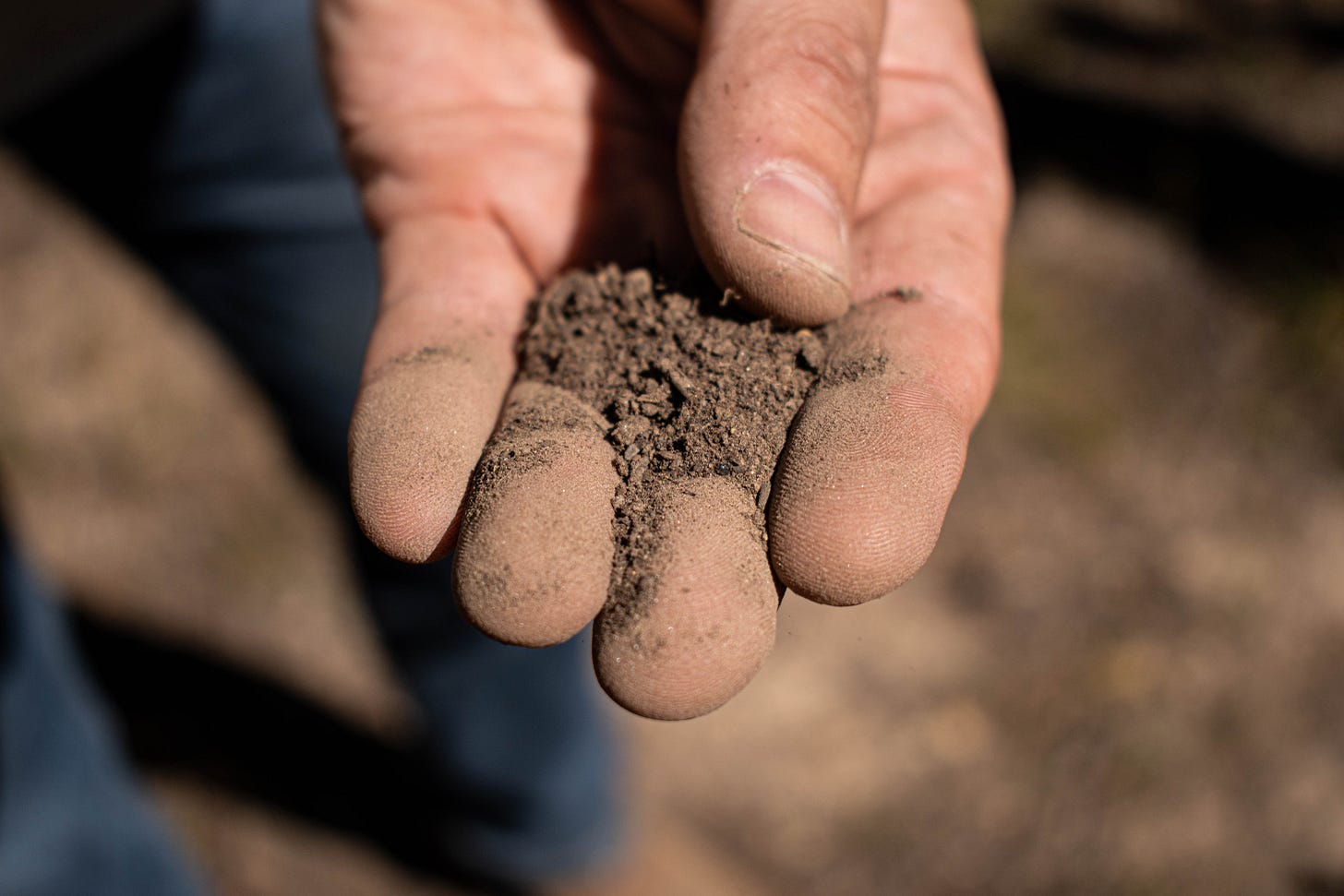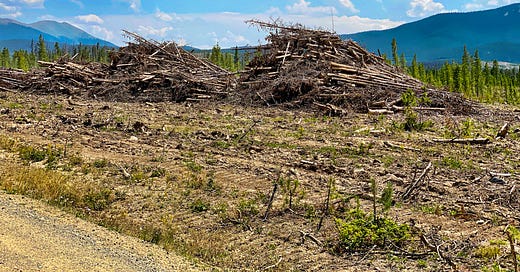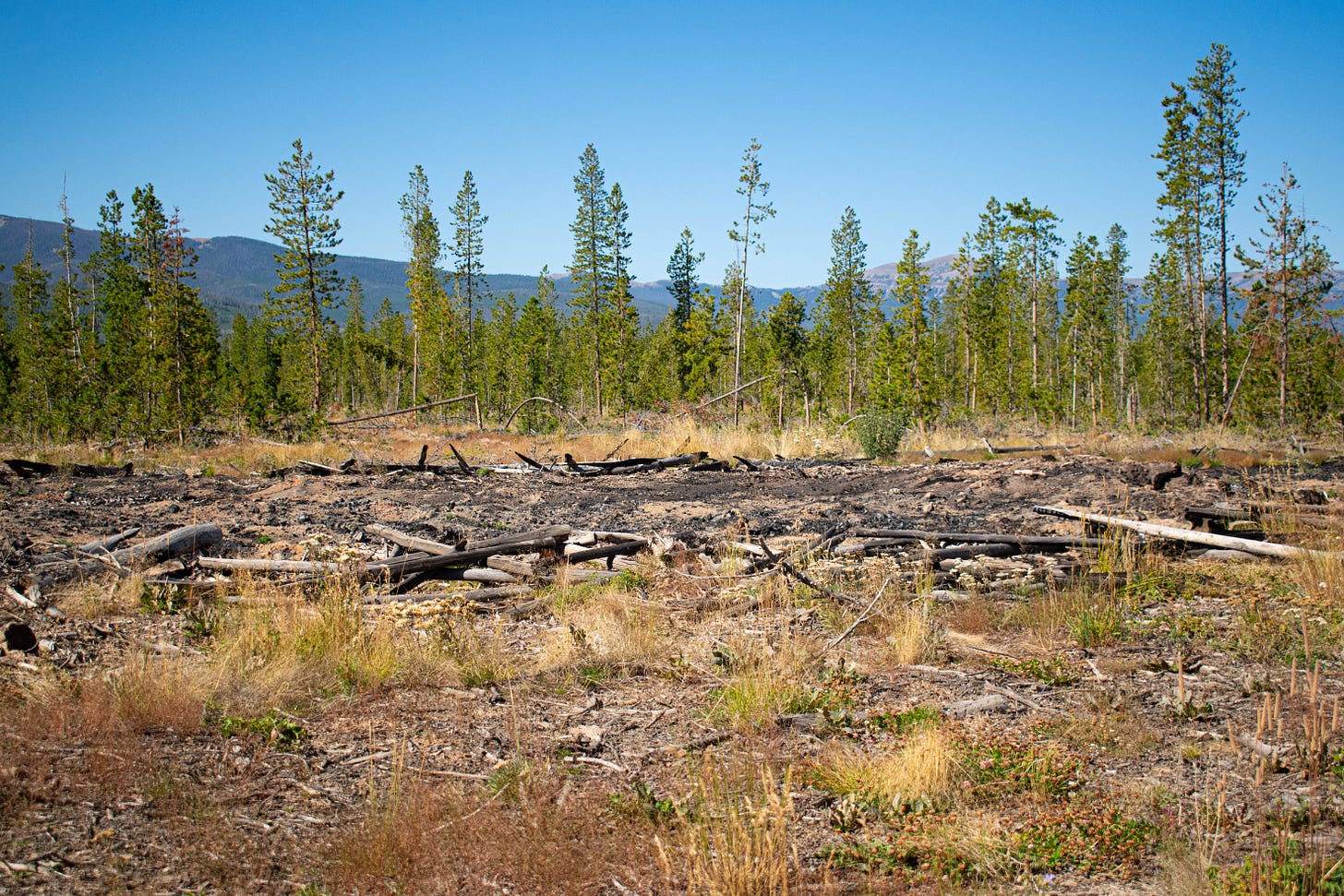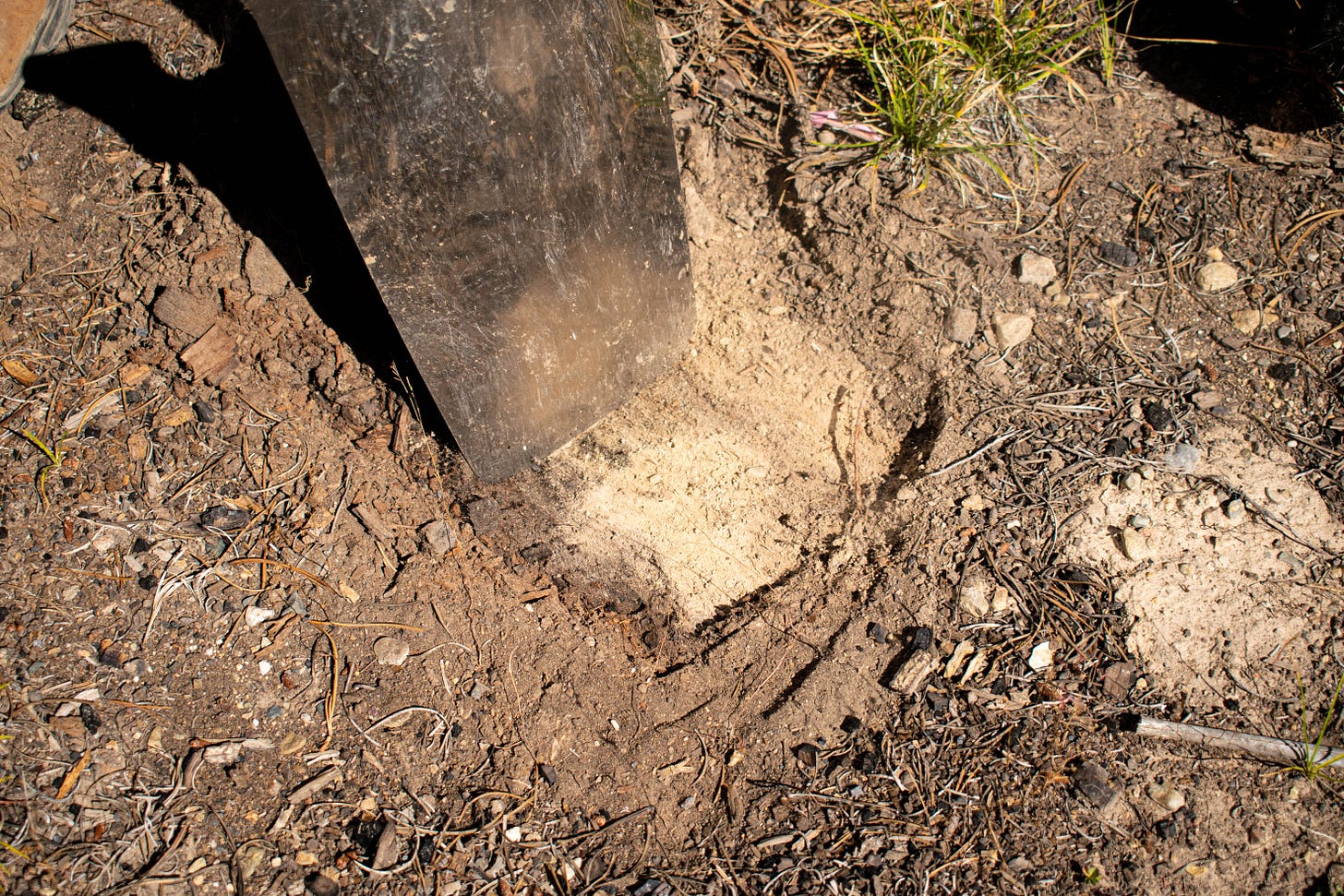🔥 Burning Questions: Field trip edition
Hitting the road for wildfire science up close and in-person
It’s fall semester, readers, and time for another installment of Burning Questions. I’m Riley Prillwitz, a recent Colorado College grad here to update you on this wildfire science research project and more news on the wildfire front this past summer.
🛣 The Road to Nowhere (or a set of coordinates in the woods)
This week, I want to tell you about an enlightening little excursion I went on.
Has anyone ever sent you a specific set of coordinates to plug into a GPS device to follow out into the wilderness? Well, that happened to me last week, and out to the wilderness I went.
That particular wilderness was Jackson County, Colorado, past where the East Troublesome fire burned two years ago. There, I met up with Mike Wilkins and Amelia Nelson. You might remember them as the lead principal investigator and Colorado State University grad student, respectively, from our past newsletters discussing their research.
They decided to take me to ground zero earlier this month, that is, to the place they collect soil samples where actual burn piles exist. It’s here in the lodgepole pine forests of North Park, Colorado, a rural area just north of the town of Walden near the Wyoming border where wildfire burn piles are the setting for this team’s groundbreaking research.

🧊 Burn pile refresher 101
With summer ending and school starting another session, it’s only fair that I help our readers brush up on their knowledge of burn piles and why they are important to understanding the consequences of wildfires in the West.
In our first edition of this newsletter, we explained them as “piles of fuel, mainly dead wood and leaf litter, collected in piles to be burned under controlled conditions as a method of fire mitigation by forest management.”
But what do these “piles” actually look like? I had trouble imagining the exact appearance of a burn pile myself, even after speaking with our research team. So this trip cleared a lot of it up for me and offered a close-up and personal bonding experience with multiple pile locations. I hope to translate that better understanding to you.
Before I got to see where researchers are collecting their soil samples, Wilkins and Nelson pulled off the side of a gravel road to show me a fresh burn site where piles had burned two years prior. Wilkins explained the change in appearance from before and after a burn, from a towering stack of forest debris to a flat, charred area of land in the wilderness. It was easy to see that a fire had indeed burned here, as it was impossible to miss the coal and charred wood that had turned the ground black.
“The soil in this area is dry, and has a PH of about 10,” Wilkins said. “Compared to pre-fire soil at about 6.”
👩🏼🔬 In the field, LARPing as a scientist
After our quick stop at these “fresh” piles, off we went deeper into the woods.
We maneuvered about the gravel roads until we arrived in a dense forestry area. We were close to three piles that were burned in the 1980s, and these were some of the piles where the researchers have extracted soil samples for their project “Role of Soil Microbiome Resilience in Ecosystem Recovery Following Severe Wildfire.” (As our first newsletter edition explained, these scientists have come together with the primary goal of understanding the importance of soil microbes in forest recovery following severe wildfire, which they’ll accomplish by studying chronosequences of burn pile scars under different experimental conditions.
“These are nice because they are right off the road and easy to get to,” Nelson said about the piles. “A lot of the others are a decent hike straight into the trees, which isn’t always fun.”
Nelson also explained the convenience of the burn piles for their research: how the soil sample piles are all within 30 miles of where we stood, how the burns were recorded and logged instead of simply burned and forgotten about (which is common), and how the research team had access to the area and the piles.
These piles are much less obvious to the untrained eye (mine), but Wilkins and Nelson knew where they were going. When we reached the first pile, at first I simply saw a small clearing with a patch of dry brown dirt and some small saplings popping up around inside it. Not much else grew inside. The area gave major fairy ring vibes and I almost didn’t want to step inside. But the researchers had no problem diving in, so I followed suit.
Around the location of the pile, small pines the size of an average Christmas tree stood. You can predict the age of a tree by the amount of branch sections running up its trunk, explained Wilkins. These were around age 10. Meanwhile, the saplings within the burn pile were 4, yet they stood only a couple inches off the ground. It was easy to see then how much harder vegetation has it trying to grow in soil burned by fire.
Wilkins then started digging a small hole in the circle. It was practically dust and slipped right through his fingers when he picked it up. As he moved portions of the brittle soil aside, patches of white ash began to show. “See that white color?” Nelson asked. “That shows the fire was burning at a high temperature.”
Wilkins compared it to the soil outside of the barren circle, and the difference was clear. It was dark and clumped together, which they told me is a much more ideal soil for trees and other forest vegetation to grow.
“I wouldn’t say this is the perfect soil for crop cultivation, but it is much more ideal than the burned soil over here,” Wilkins said.
We continued through the dense forest to find two other burn piles, led by Nelson, her handy-dandy GPS, and Wilkins’ black lab Cedric (giant stick in tow). These other piles didn’t differ much from the first one, other than a couple of ongoing science projects involving growing saplings or involving insects. My guides assured me that the burn piles from the other decades did not differ in looks either.
And they were right. Other than a slight change in location, steepness of the forest floor, and a couple of large animal bones, there really didn’t appear much change between the piles. Nothing was really growing inside. The saplings were small, short, and frail. The brittle soil simply did not seem an ideal place for plants to grow.
And that makes sense. In our last newsletter edition, Nelson told us her preliminary research found that “it takes 60 years for them to not look statistically different from the communities in the control sample.” Conversely, the piles I saw were only about 40 years old.
🧮 The method behind the madness
So, why did I drive such a long way to look at dirt?
I, for one, have been waiting for this trip since the inaugural edition of this newsletter last November for a simple reason: science is cool. Following the science means learning something new each day, and the particular research this team is doing uncovers new information about wildfires and forest regeneration that no one has really studied before. How is that not cool?
But more importantly, you, the readers, are hopefully gaining a better understanding behind what they’re doing and the fancy jargon we’ve thrown at you (and broken down for you) since the beginning, which has been our goal all along.
By reading my recent first-hand experience, hopefully you will be able to put yourself in my shoes. The more we understand about our surrounding environment, including wildfires, the better equipped we will become at combating Miss Climate Change herself.
Growing up in Oregon, I remember driving through areas affected by wildfire and feeling an overwhelming sense of grief as I saw the blackened, charred trunks of the Douglas firs. But as I drove back home from these burn piles in northern Colorado, back through where the East Troublesome fire burned, for the first time in my life I didn’t feel that sadness.
Because now I understand. I understand the natural cycle of the forest, and how plants regrow, and the soil regenerates, albeit over many, many decades. And I hope this newsletter has helped you understand as well. While wildfires may be scary and destructive, with them they can bring new life. Some of what these researchers are trying to discover is just how long that takes.
🔥Wildfire Wire🔥
🔬 “As wildfires cause increasing devastation worldwide, dozens of fire experts across the nation are joining together in calling for a more strategic and interdisciplinary approach to pursuing wildfire research and protecting vulnerable communities,” wrote Chrystian Tejedor at Florida International University. (Find the full study here, where the experts write: “Only through overcoming institutional silos and accessing knowledge across diverse communities can we effectively undertake research that improves outcomes in our more fiery future.”
🚒 As I wrote this newsletter in early September, a grassland fire was burning in Larimer County, near Fort Collins, Colorado. No injuries or substantial damages were reported at the time, though authorities issued evacuation and smoke warnings for the area. It has since been 100 percent contained. Meanwhile, in California, a raging wildfire “pumped out a monster cloud towering 40,000 feet into the atmosphere,” with one news reporter describing it “like a scene out of an apocalyptic movie.”
🌧 You might have noticed that, despite the sweltering heat this summer, there has been less major wildfire news throughout Colorado this season. (At least compared to last year.) According to The Colorado Sun’s Olivia Prentzel, we have the thunderstorms to thank. Because of above-average rain levels brought in by the summer storms, fires have been quelled. Still, the fall is expected to bring above-average temperatures and less rain, so larger wildfires could pop back up.
🌱 The summer monsoons did more than mitigate the threat of wildfires in the state, they also helped bring back vegetation burned from spring fires. A cattle ranch destroyed in the Lamar fire in April now sees fresh vegetation and green pastures fit for a herd of cattle to graze, all thanks to the rain. Michael Booth has that story here.
🥇 The year 2022, however, has brought a new national record as the most active for wildfires in more than a decade. Cory Reppenhagen at Denver’s 9 News reported that while Colorado has had a relatively mellow summer in terms of wildfires, “More than six million acres (6,153,171 acres) of land has burned in the U.S. since Jan. 1.” Most of the western United States has not received the same amount of rain that Colorado has seen this hot and dry summer.
💨 Earlier this week, Coloradans might have experienced more smokey conditions in the air. That’s because current burning wildfires in the western United States have been blowing toward us — so much so that on Wednesday there was an air quality alert. The heat advisories and fire watch alerts continue to distribute to Colorado residents, but Coloradans experienced a small break with cooler weather over the past weekend.
🔥 “From California’s crimson skies to smoke so thick along Colorado’s front range that sent people indoors for days, wildfires in the US have becomes more and more extreme,” reported the podcast “How to Save a Planet.” On this episode, the team asked: “how did the wildfires get so bad – and what can we do to address them?”
🛩 Colorado has launched an initiative called the Multi-Mission Aircraft program to better combat wildfires with “military grade” tech. The program uses “infrared and geospatial technology” in order to track and “contain fires throughout the state.” The Glenwood Springs Post-Independent’s Cassandra Ballard has the story.
🌲 “New data on forest fires confirms what we’ve long feared: Forest fires are becoming more widespread, burning nearly twice as much tree cover today as they did 20 years ago,” according to the World Resources Institute.
📜Colorado lawmakers are drafting 10 new bills that could prevent wildfires and improve wildfire safety, reported Scott Franz at KUNC. After failed attempts to pass new laws earlier in the year, lawmakers are planning to head back to the drawing board to get some of the previously proposed laws, as well as newly edited ones, passed the second time around. Some of these drafts include updated building codes, funding for fire detection cameras, and investments for wildfire investigations.
🚦Meanwhile, earlier this month, four new bills involving wildfire safety that did get passed went into effect, reported Hannah Metzger at Colorado Politics. The bills mostly involve how authorities “prevent and respond” to wildfires in the state, as well as insurance coverage for wildfires.
❄️ “Smoke from hundreds of wildfires darkened skies over the Alaskan Interior this summer, with the state experiencing its fastest start to the fire season on record amid hot and dry conditions,” Reuters reported.
🏕 We know how much outdoor sports mean to Coloradans, which is why an article in 5280 magazine by Ryan Wichelns might tickle your fancy. The author rounded up the most important gear for wildfire safety and camping must-haves during wildfire season that will make sure your next adventure in the wilderness is the safest one yet.
🧠 For MindSiteNews, Kate Ruder reported how a Colorado community put mental health first after a wildfire.
💦 “Wildfires and their consequences, such as landslides, are exacerbated by the effects of climate change and are resulting in devastation in many regions of the nation,” said Bruce Hamilton, a program director in NSF’s Directorate for Engineering, who explained how new research “can help us anticipate and mitigate those impacts."
🖼 Therapists in Colorado are helping wildfire victims overcome the trauma of their experiences with art therapy, according to Yale Climate Connections. Andrea Golod created the project after her own experience with fire evacuations.
👩🏻🚒 “Prescribed burns are key to reducing the risk of catastrophic wildfires,” reported Raymond Zhong for The New York Times. “Scientists are using high-tech tools to ensure they can be done safely in a warming world.”
🏫 A new CU Boulder college course created by the Boulder Reporting Lab and the Center for Environmental Journalism, called “Marshall Fire as Living Lab,” will examine health impacts from the Marshall Fire. Graduate students “will report on the effects on water, air, soil and more from the most destructive wildfire in Colorado history, as residents rebuild their homes and lives.”
➡️ “Most Americans who have faced extreme weather see a link to climate change — Republicans included,” the PEW Research Center found.
I’m Riley Prillwitz, a recent Colorado College graduate living in Denver. Burning Questions seeks to help bridge a gap between wildfire science research and journalism, and is a project of the Colorado College Journalism Institute with support from a National Science Foundation grant. Learn more about this newsletter here. 📬 Enter your email address to subscribe and get Burning Questions delivered to your inbox each time it comes out. You can reach us with questions, feedback, or tips by emailing burningquestionscc@gmail.com






